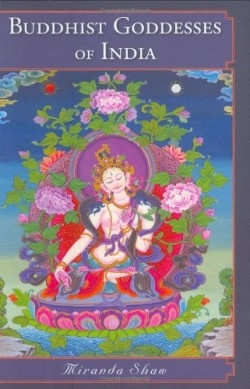Buddhist Goddesses of India
- 2006 INDIES Winner
- Gold, Religion (Adult Nonfiction)
Goddesses have always formed a pervasive and important aspect of Indian Buddhism, but until recently, they have received little in-depth attention from academics. The author corrects this, asserting: “Although Buddhism has not heretofore been examined from this perspective, an in-depth exploration of the female pantheon reveals a lively, long-standing, and profound engagement with the female.”
Shaw divides the book into three sections, dealing respectively with early goddesses (around third century B.C.E.), Mahayana divinities (first to seventh centuries C.E.), and Tantric female Buddhas (seventh to twelfth centuries C.E.). She devotes a chapter to each divinity, providing a phonetic pronunciation for each name and a translation wherever the name’s etymology is discernible.
It becomes clear that divine females have inhabited Buddhism from its inception. In the book’s first section, Shaw relates that Prithivi (PRI-thi-VEE; “Vast One”) witnessed the exact moment of the Buddha’s enlightenment, driving back the demons who sought to impede this event. An earth deity, she nurtures all living things but also presides over oaths and ratifies any words spoken in honesty.
Goddesses exist for all aspects of life, both physical and spiritual, indicating no split between spirit and matter on the path to enlightenment. For example, devotees could receive purification of karma and quickened spiritual development from Cunda (Chun-DAH, “Motivator”); protection from illness and epidemics from Parnasavari (PAR-na-sha-va-REE, “Tribal Woman Clothed in Leaves”); the gifts of art, culture, and the intellect from Saraswati (Sah-RAS-swa-TEE, “Lady of the Waters” or “Flowing One”); and aid for any need or want from Tara (TAH-RAH, “She Who Carries Across”), whose worship under various manifestations pervades all of Asia.
As Shaw points out, Tara is an interesting case because she straddles both Mahayana and Tantric traditions. Though she is part of the former group, she is the first deity to attain full Buddhahood, and as such, also belongs to the almost manic Tantric Goddesses of the book’s third section. Copious photos of friezes, sculpture, and paintings help readers visualize the text throughout the book, and the Tantric deities explode with exuberance.
Pictured in dancing poses, hair swinging wildly and genitals exposed, the Tantrics wear only jewelry, symbolizing the complete freedom brought by reaching Buddha status. Their ferocious and even shocking appearance affirms that far from being obstacles, intense passions can forcefully assist the process of spiritual liberation. In one representation, Vajrayogini (Vaj-rah-YOH-ghee-NEE, “Adamantine Yogini”) appears with tusks, in wrathful gaze, ready to charge any impediment to enlightenment; in another, she is shown in the act of coitus with her consort. Chinamunda (Che-nah-MOON-DAH “Severed-Headed Goddess”) holds her own head aloft and drinks the blood spurting from her neck, interpreted as yogic purification and the self-nourishment resulting from spiritual bliss.
The author is an associate professor of religion at the University of Richmond, and her research included four trips to India and Nepal. Hoping to serve a broad range of scholars, Shaw purposely wrote each chapter as an independent stand-alone reference on a given deity. She also includes one chapter on the Flower Ornament Scripture, which contains a number of goddesses, and one on the concept of the Yaksinis (YAHK-shee-NEES, etymology unclear*)*, benevolent figures that grace many Buddhist monuments.
Though the author admits that no work of this scope could be comprehensive, her book represents a remarkable offering. Buddhist Goddesses of India will delight and entice students of religious studies, cultural anthropologists, art history enthusiasts, goddess spirituality practitioners, and anyone interested in the divine feminine.
Reviewed by
Leah Samul
Disclosure: This article is not an endorsement, but a review. The publisher of this book provided free copies of the book to have their book reviewed by a professional reviewer. No fee was paid by the publisher for this review. Foreword Reviews only recommends books that we love. Foreword Magazine, Inc. is disclosing this in accordance with the Federal Trade Commission’s 16 CFR, Part 255.

